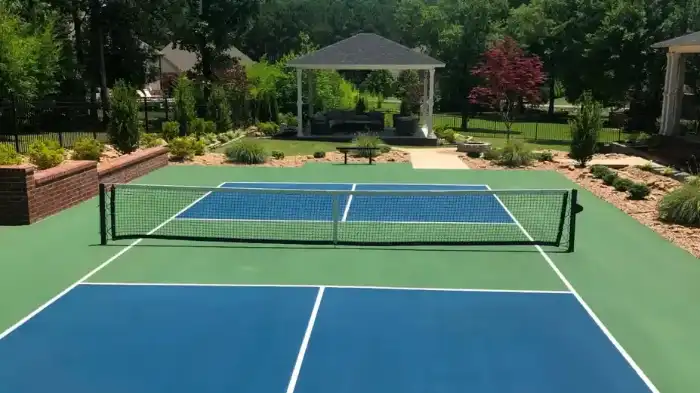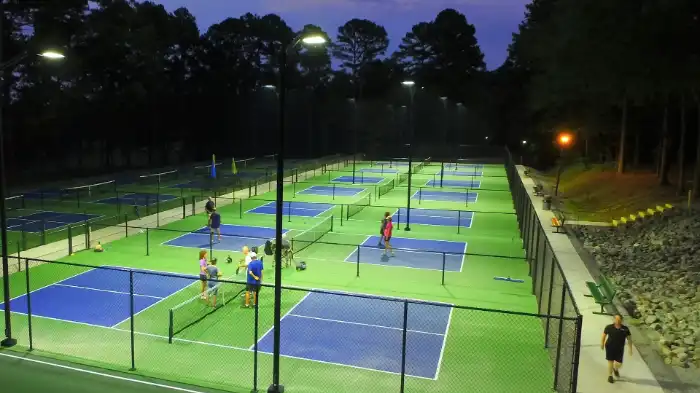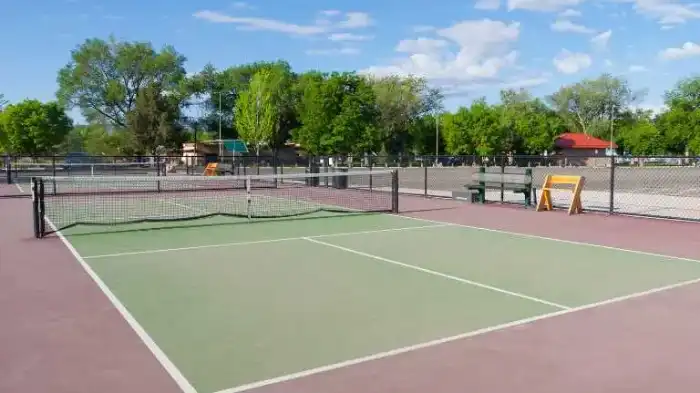Are you ready to embark on the journey of building pickleball courts that players will flock to, creating the ultimate pickleball paradise? In this guide, we’ll take you through the essential steps, from selecting the perfect location to ensuring a well-lit and safe environment. Let’s dive into the world of building pickleball courts and create a haven for enthusiasts of this fast-growing sport.
Steps for Building Pickleball Courts
1. Choosing the Right Location
The first step towards creating the perfect pickleball paradise by building pickleball courts is selecting the ideal location. Consider the following aspects:
1.1 Space Availability: An adequate amount of space is necessary to accommodate a full-sized pickleball court with proper boundaries. Ensure that the location has enough room to avoid any cramped or restricted playing areas.
1.2 Proximity and Accessibility: Choose a location that is easily accessible for players and visitors. Consider proximity to residential areas, parking facilities, and public transportation options. Easy access will attract more players and make your pickleball paradise more popular.
1.3 Natural Lighting and Wind Considerations: Maximize natural lighting as much as possible to create an enjoyable playing experience. Additionally, observe wind patterns in the area to ensure they don’t interfere with gameplay. Strong gusts can affect the flight of the pickleball, making it more challenging for players.
2. Court Design and Layout
The design and layout of the court greatly influence the quality of play. Here are some essential aspects to consider:
2.1 Court Surface: Choose a surface that provides excellent grip and eliminates the risk of slips or falls. Most pickleball courts are constructed using asphalt or concrete, but there are also specialized cushioned surfaces available that reduce the impact on players’ joints.

2.2 Court Markings: Clear and accurate court markings are crucial for players to follow the rules and boundaries. Utilize high-quality paint or tapes to mark the pickleball court lines and ensure their durability against weather conditions and regular wear.
2.3 Net System: Invest in a high-quality net system that is sturdy and adjustable. The net should be mounted at the regulation height of 36 inches at the center and 34 inches on the ends to ensure fair gameplay.
3. Lighting and Fencing
Proper lighting and fencing are important aspects to enhance safety and convenience:
3.1 Lighting: Install adequate lighting to ensure visibility during evening hours or in indoor facilities. LED lights are energy-efficient and provide excellent illumination, ensuring players can clearly see the ball and move around the court safely.
3.2 Fencing: Enclose the court with durable fencing to prevent stray balls from interfering with other games or causing any injuries. Mesh-style fencing is commonly used in pickleball courts due to its ability to absorb and minimize ball impact.

4. Amenities and Seating
To create a top-class pickleball paradise, consider the comfort and convenience of players and spectators:
4.1 Player Benches: Provide player benches or seating areas near the court to allow participants to rest between games or during breaks. Ensure the seating is comfortable and well-maintained.
4.2 Shade Structures: In areas with intense sunlight or diverse weather conditions, install shade structures or canopies to protect players and spectators from excessive heat or rain.
4.3 Storage Area: Incorporate a storage area or small shed to keep pickleball equipment organized and protected from weather elements. This will help maintain the condition and longevity of the equipment.
5. Maintenance and Upkeep
Maintaining your pickleball courts will ensure their longevity and continued enjoyment for players:
5.1 Regular Cleaning: Regularly sweep and clean the court surface to remove debris, leaves, and any other foreign materials that may affect gameplay. This will also prevent moss or mold from forming and causing slipping hazards.
5.2 Repair and Resurfacing: Monitor the court for any damages or cracks regularly. Repair any cracks or uneven surfaces promptly to prevent accidents and maintain a smooth playing area. Schedule resurfacing as needed to keep the court in top condition.
5.3 Net Replacement: Inspect the net system periodically to ensure it is secure and functioning correctly. Replace nets when they show signs of wear or damage to maintain fair play.
Frequently Asked Questions
For building pickleball courts, you should focus on selecting the right location, ensuring proper space for multiple courts, using high-quality materials such as durable surfaces and nets, incorporating proper lighting, and ensuring ample seating and amenities for players.
The number of courts depends on the demand and availability of space. It is advisable to have a minimum of four courts to accommodate both casual and competitive players. However, if space allows, expanding to more courts can attract a larger player base.
Good lighting is a crucial feature of any top-tier court. It allows for extended playability during evenings or darker seasons and ensures player safety. LED lighting is recommended as it provides excellent visibility, energy efficiency, and minimal maintenance.
To create an inviting atmosphere, consider amenities such as shaded seating areas, water fountains, scoreboards, and ample storage for equipment. Additionally, well-maintained restrooms and access to drinking water are essential for player comfort and convenience.
Regular cleaning, repair of damages, and timely resurfacing are key maintenance tasks. Additionally, inspect the net system periodically and replace nets when signs of wear or damage appear.
Yes, the net should have the correct tension. It should be tight enough to prevent it from sagging but not so tight that it distorts the net height, which should be 36 inches at the center and 34 inches at the ends. Proper net tension ensures fair play.
Conclusion
In the end, creating the perfect pickleball paradise is all about the details and dedication to building pickleball courts that excel in design, safety, and functionality. By carefully choosing the right location, surface, net system, lighting, and amenities, you’ll ensure that your pickleball courts stand as shining examples of excellence in the world of pickleball. Now, it’s time to put these tips into practice and get started on building pickleball courts that will be enjoyed by players for years to come.

